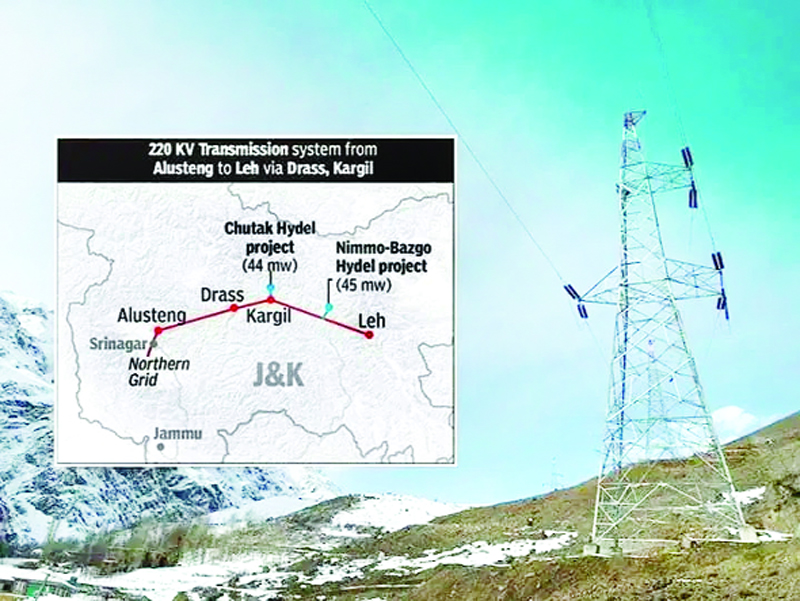‘Ladakh formally connected to National Grid’
Gopal Sharma
JAMMU, May 28: The Union Ministry of Power today transferred the prestigious 220 KV Srinagar-Drass Kargil-Leh Transmission system to the Power Grid Corporation of India Limited (POWERGRID). With this, entire Union Territory of Ladakh was formly connected to the National Grid.
Built at a height of around 3000-4000 meters, this 334 kms long transmission line traverses snow-bound difficult hilly terrain. It comprised of four new state-of- the-art 220/66 KV gas insulated sub-stations and 66 KV inter-connection systems at Drass, Kargil, Khaltsi and Leh.
“The Project was executed by POWERGRID on consutancy basis under Prime Minister’s Reconstruction Plan (PMRP) Scheme. Subsequent to reorganization of the erstwhile State of Jammu and Kashmir into Union Territories of J&K and Ladakh, the 220 KV Srinagar-Leh Transmission system has been re-designated as the Inter State Transmission System (ISTS) and transferred to POWERGRID with effect from October 31, 2019, the date of formation of the two UTs of J&K and Ladakh,” Naresh Kumar, senior General Manager, POWERGRID said.
Prime Minister, Narendra Modi had dedicated the 220 KV Srinagar- Alusteng – Drass- Kargil – LehTransmission system to the nation on February 3, 2019, thus providing boost to the tourism sector and enhancing socio-economic development of Ladakh. Modi had laid the foundation stone for this project on August 12, 2014 and within 4.5 years, the project was completed by the Power Grid Corporation of India Limited (POWERGRID), a Company of Government of India, under Ministry of Power. While inaugurating this projects PM said, “We’ve left behind culture of delays.”
“The Rs 2266 crore project will result in minimizing the massive use of diesel generating sets during winters, and thus will help in protection of beautiful environment and pristine glowry of Ladakh region. It will help to ensure 24×7 quality power in all weather conditions. Funding provisions were in the ratio of 95:05 (95% Govt of India share and 5% J&K State share),” Kumar said.
The General Manager further said the implementation of this project was also aimed to supply power to the people of Ladakh in harsh winters and evacuation of surplus power of Kargil & Leh Hydel stations of NHPC in summers. It is a flagship project of Government of India, under PMRP scheme which was aimed to improve reliability & quality of power supply in Ladakh region of J&K by connecting with National Grid.
This will not only help evacuate power in summers, but will also supply power to the region in winters when temperatures dip and hydro electricity generation do not match up. The project will meet the power demand of Ladakh region at economical rates. With quality electricity available at reasonable rates, hospitality industry in Ladakh will get a boost, as their reliance on diesel sets will reduce. This will also attract tourists looking for affordable stay in all weathers, he added.
The GM said this herculean task executed by POWERGRID in unforeseen weather conditions was made possible by immaculate project monitoring skills, high team spirit and strategic planning and use of modern technologies. The line remains snow covered for nearly six months with the minimum temperature going down to as low as -40 degrees at Drass.
Therefore, specially designed tower foundations were constructed with assistance from Snow & Avalanche Study Establishment (SASE) for spotting the tower foundations, as the work force braved the challenge of working at lesser oxygen levels. It shall also provide grid connectivity and reliable quality power supply to the strategically important Ladakh region including defence establishments in the area, Kumar said.
POWERGRID is one of the world’s largest Power Transmission utility, and has a wide network of 150,874 circuit kilometers transmission lines, with 238 Sub-stations and transformation capacity of 351,106 MVA, the GM claimed.


